Thermal Characterization of High-Voltage Batteries
The thermal characterization of high-voltage batteries requires precise temperature measurements down to cell level with a large number of sensors. Only with precise insights in the thermal behaviour of battery cells and the whole system further optimization can be performed. With the HV DTemp measurement system, temperatures on the cell level can be measured with up to 512 sensors on only one sensor cable.

Background
The performance of high-voltage batteries based on lithium-ion is significantly affected by temperature, due to the chemical properties. The optimum working temperature for lithium-ion batteries ranges from 15 °C to 35 °C. At lower temperatures, the chemical processes in the battery are significantly slowed down, which reduces the energy and performance capability. Excessively high temperatures have the similar effects, but in extreme cases they can also lead to self-destruction (by so called thermal runaway) and fire in the battery. A major source of high internal temperatures is caused by heat generation inside the battery, which is caused by charge transfer and chemical reactions during charging and discharging. Over time, different temperatures occur during different load conditions.
The spatial distribution of temperatures is also by no means uniform: even within a single cell, the temperatures of different areas differ significantly from one another. Dangers can arise from locally limited areas with very high temperatures - so-called hot spots. These increase the risk of internal short circuits, which in turn can lead to a thermal runaway. These hazards affect all typical cell designs - cylindrical cells, prismatic cells or pouch cells - equally.
To avoid undesirable effects of thermal behaviour, high-voltage batteries are equipped with extensive temperature management and cooling systems to ensure operation in the optimum temperature range. In addition, it is thought to achieve an even temperature distribution within the battery as well as insulation against external influences.
For the development of suitable temperature management systems, the thermal behaviour of all components within the battery housing must be known. Simulations are often used in the development phase. However, simulations often cannot describe the complex chemical processes and their effects within the battery precisely enough for all situations, so that extensive measurements are necessary. Only with a precise investigation of the thermal behaviour of the individual battery cell as well as the complete high-voltage battery can a precise characterization be made and simulation models be validated. The findings will enable further optimization of the battery and the temperature management system.
The thermal characterization of high-voltage batteries places high demands on measurement technology with regard to the number of sensors required, the space needed and the avoidance of interference factors. Several hundred sensors are required to determine precise temperature profiles also at cell level. The sensors and their sensor cables must be small enough to be placed between the cells. The arrangement of the sensors should be as flexible as possible in order to be able to detect temperature profiles and hot spots. Furthermore, it must also be possible to install needed measurement equipment inside or outside the battery in confined space. The structural change of the battery caused by additional large objects inside the battery or a large number of openings in the battery housing for sensor cables should be as small as possible. Otherwise, the measurement results would be falsified too much to obtain a realistic picture of the temperature behaviour.
The following example shows how such a complex temperature measurement for the characterization of a high-voltage battery is performed with the HV DTemp measurement system.
Measurement task
Acquisition of temperature profiles in high-voltage battery cells to validate simulations and optimally design heat and cooling systems.
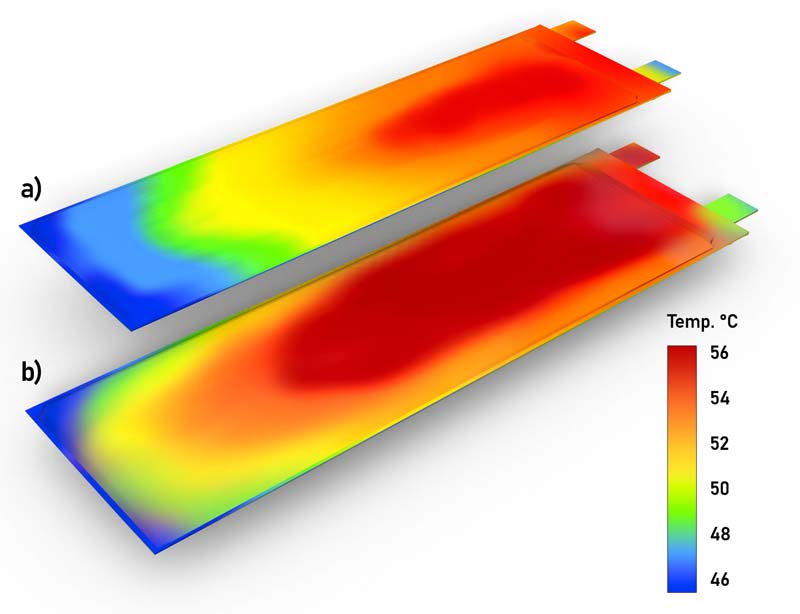
a) Simulation b) Measurement result.
Clearly visible is the deviation in the amount and spread of the temperatures. Real measurements are essential for an accurate characterization.
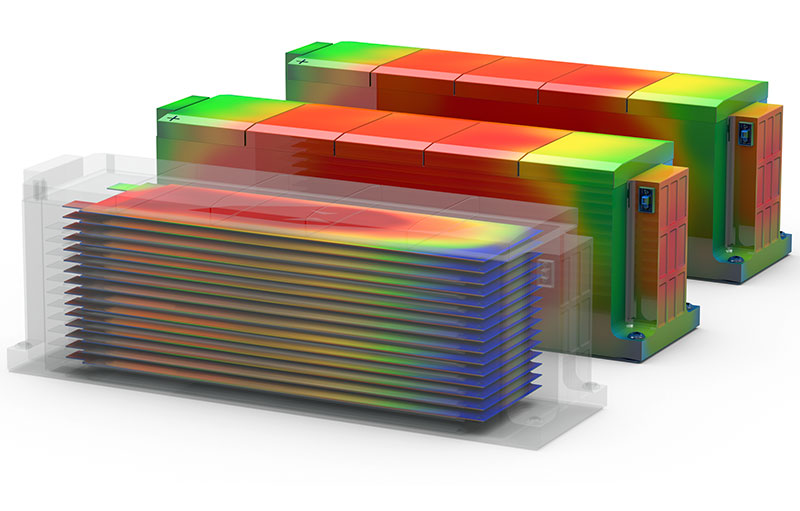

Challenge
The large number of temperature sensors requires a correspondingly large amount of sensor cables and measurement modules. There is often no space in the battery blocks and housings for this measurement technology.
For placing the sensors between the battery cells, the sensors and sensor cables have to be made extremely thin. The application of the sensors should be easy and fast, otherwise too much time is lost for the application of hundreds of measurement points. For the verification of the temperature models, it should be possible to define the measurement points using the simulations and plan the layout in CAD. An exact transfer of the calculated measurement points and reproducible arrangement of the sensors ensures better measurement results.
The measurement object should be influenced by the measurement technology as little as possible in order not to falsify the measurement results. In addition, interferences on the sensor cables, which occur with large bundles of sensor cables, should be avoided.
Last but not least, the measurement technology must ensure safety for the user and the system during measurements in a high-voltage environment.
Requirements for temperature measurement
- Synchronous acquisition of up to several hundred measurement points inside and outside the high-voltage battery
- Low space requirement of the measurement system
- Very thin temperature sensors and sensor cables for placement between the battery cells
- Plannable, flexible and reproducible arrangement of the measurement points
- Minor impact to structure of the battery housing by sensor cables
- Interference-free data acquisition and transmission with easy recognition of interference signals and errors

The CSM Measurement Solution
The HV DTemp measurement system was developed especially for such measurement tasks. The CSM HV DTemp measurement system allows the digital and therefore interference-free acquisition of up to 512 temperature measurement points via a single sensor cable to the HV DTemp-P central unit.
- High-voltage safe sensor cable
512 measurement points are acquired with only one sensor cable - HV DTemp-P Central Unit
Acquires all measurement data and transmits them via CAN bus - HV DTemp-M32i pro Controller
Addressing and power supply of the sensors - HV DTemp IC Sensors
8 IC temperature sensors on an ultra-thin flexible circuit. The layout can be selected according to the application - HV DTemp IC Sensors
Single IC temperature sensor - HV DTemp-M64i Controller
Connection for up to 64 temperature sensors

- Extremely small IC (Integrated Circuit) temperature sensors are used to measure the temperatures between the battery cells or at other points in the battery housing. The sensors are soldered on flexprint foil and measure the temperatures on their bottom surface. Due to the low height of the HV DTemp IC Sensors, sensors can also be pressed between the battery pouch cells. Depending on the measurement point, HV DTemp IC Sensors are installed in different variants.
- For the measurement on power busbars the sensors are used as single sensors with a connection cable for direct connection to a HV DTemp Controller.
- Up to four IC temperature sensors can be combined as a sensor assembly for the measurement of temperatures on the battery housings. They are either daisy-chained via connecting cables or connected via a small distribution board.
- Between the battery cells, many temperature sensors are arranged as ultra-thin flexible circuit. The arrangement can be selected project-specifically and is also reproducible.
- The HV DTemp IC Sensors are connected via HV DTemp-Mx Controller. Up to 16 sensor assemblies (equivalent to 64 temperature sensors) can be connected to one Controller. Up to 8 Controller can be easily cascaded to provide connections for up to 512 temperature sensors. The Controller address the sensors, supply them with power and transmit the temperature values to the Central Unit.
- All Controller are connected to the HV DTemp Central Unit via only one high-voltage safe sensor cable. This means that only one breakthrough with PG screw connection has to be drilled into the battery housing. The influence on the structure of the housing remains minimal.
- The HV DTemp-P Central Unit collects the data from the Controller and ensures high-voltage safety through galvanically isolated inputs. In addition, the Central Unit assigns an individual CAN-ID to each measurement point, which enables easy identification. The collected temperature data is transferred to the measurement computer via a CAN bus.
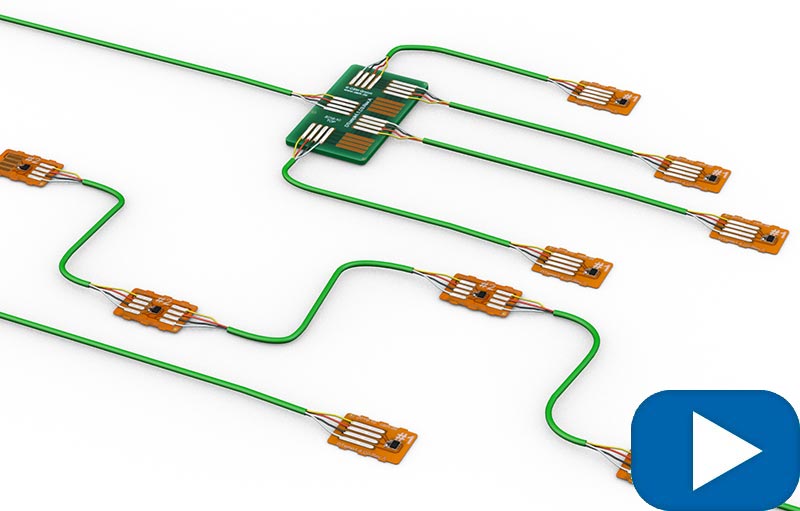
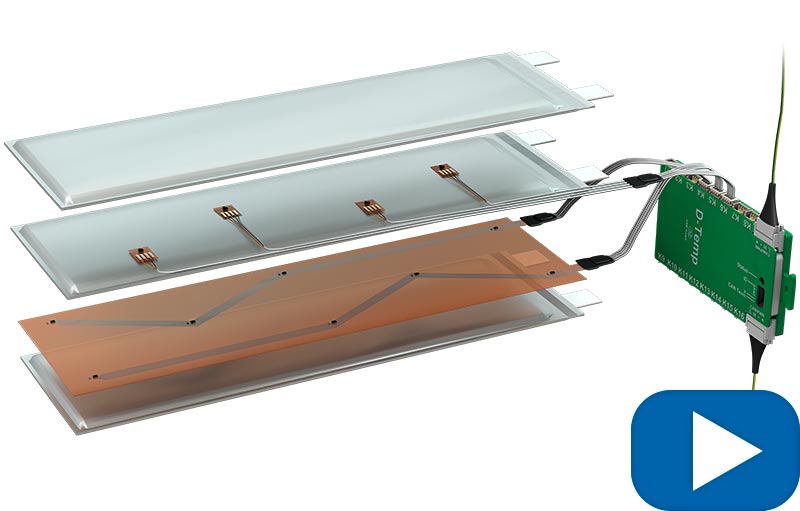
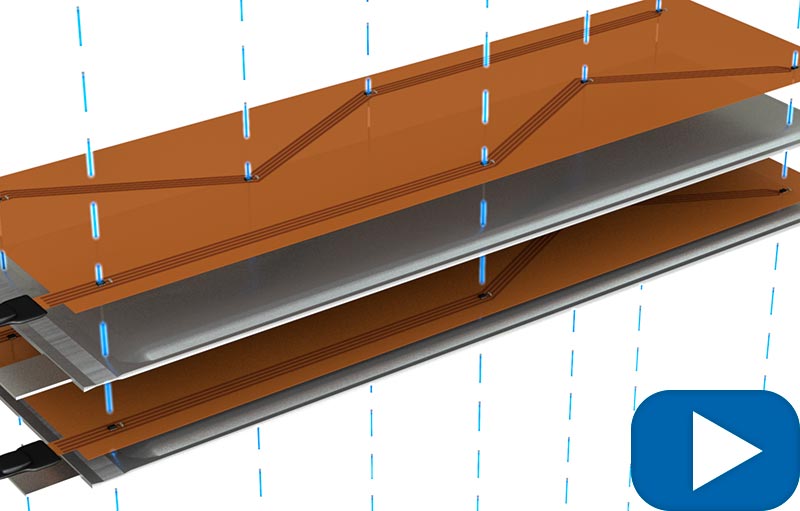
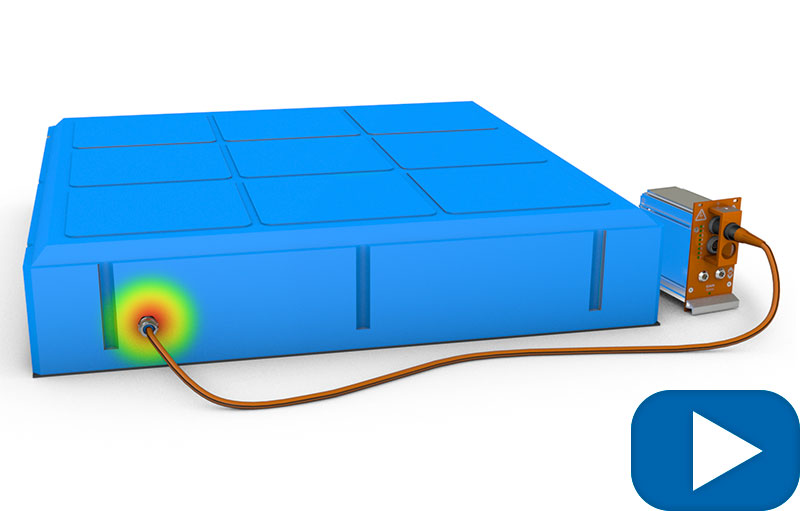
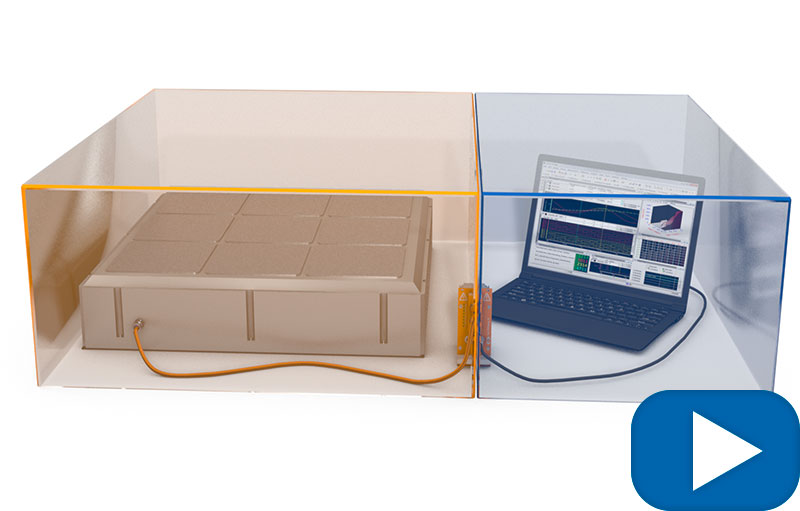

Benefits
The entire HV DTemp measurement system meets the requirements regarding the available installation space. The sensors can be positioned between the cells and thus allow the precise acquisition of temperature profiles at cell level. Due to the single or group arrangement, the arrangement is so flexible that temperature paths or hot spot areas can be measured precisely depending on the requirements. The positioning of the sensors in the group arrangement can be repeated exactly from cell to cell.
The HV DTemp-M64 Controller Modules are designed so slim that they can be installed in the battery housing. Since only one measurement module is required outside the battery, the design is extremely space-saving and cables have only minor impact on the battery structure.
The digital transmission of the measurement data ensures interference-free transmission and accurate identification of the measurement points. Interferences on the sensor cables and thus falsified measured values, as is possible with analogue sensors, are avoided. The precise identification of the sensors allows easy control of proper operation and error detection.
Via the CAN bus, the measurement system can easily be combined with other measurement modules for the acquisition of further measured values or integrated into existing measurement setups.
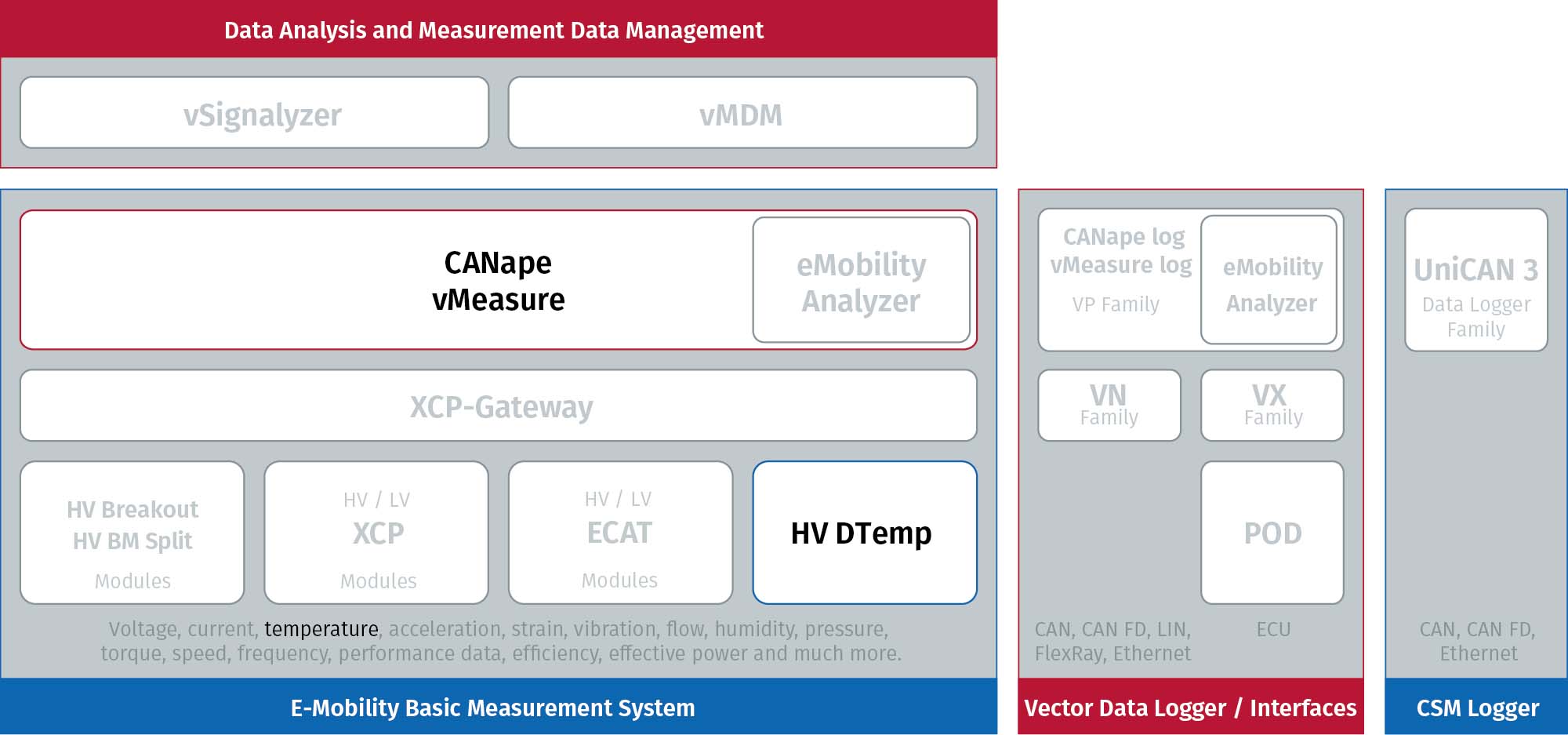

More Information
Download
Here you find the complete application example for download as PDF.
Featured Products
Related Hardware
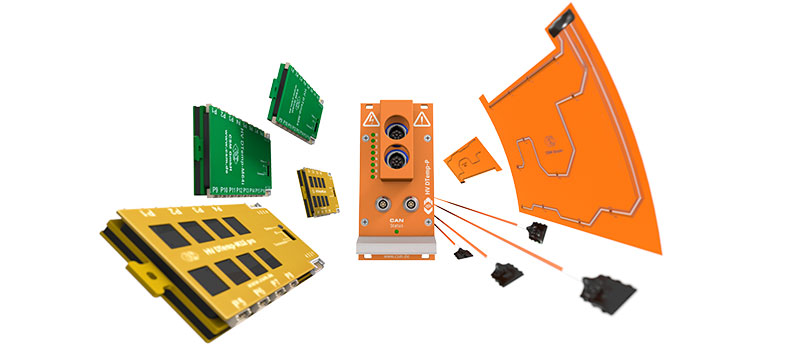
HV DTemp Measurement System
Digital temperature measurement with up to 512 measurement points
The CSM HV DTemp measurement system is designed for the digital and precise measurement of up to 512 temperature measurement points via a single cable connection to the HV DTemp Central Unit.

The Vector CSM E-Mobility Measurement System
The measurement system for the development of electric mobility
Related Software
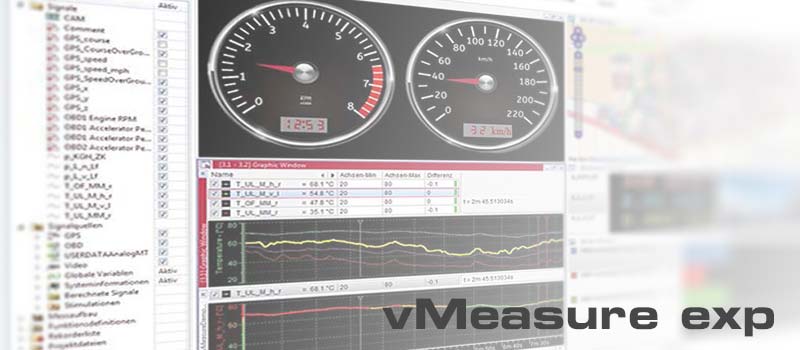
vMeasure
Reliably Solving Complex Measurement Tasks
vMeasure, developed by Vector Informatik, is an easy-to-use software tool for the acquisition and analysis of measurement data that can be used in combination with all CAN- and EtherCAT®-based CSM measurement modules. CSMconfig was integrated directly to ensure swift configuration.


Swift configuration of measurement chains: CSMconfig is the reliable configuration software for all CAN and EtherCAT® based measurement modules from CSM. The clearly arranged and easy-to-use user interface allows an easy setting of all measurement parameters. This helps speeding up the measurement setup considerably.

 Home
Home Newsletter
Newsletter




